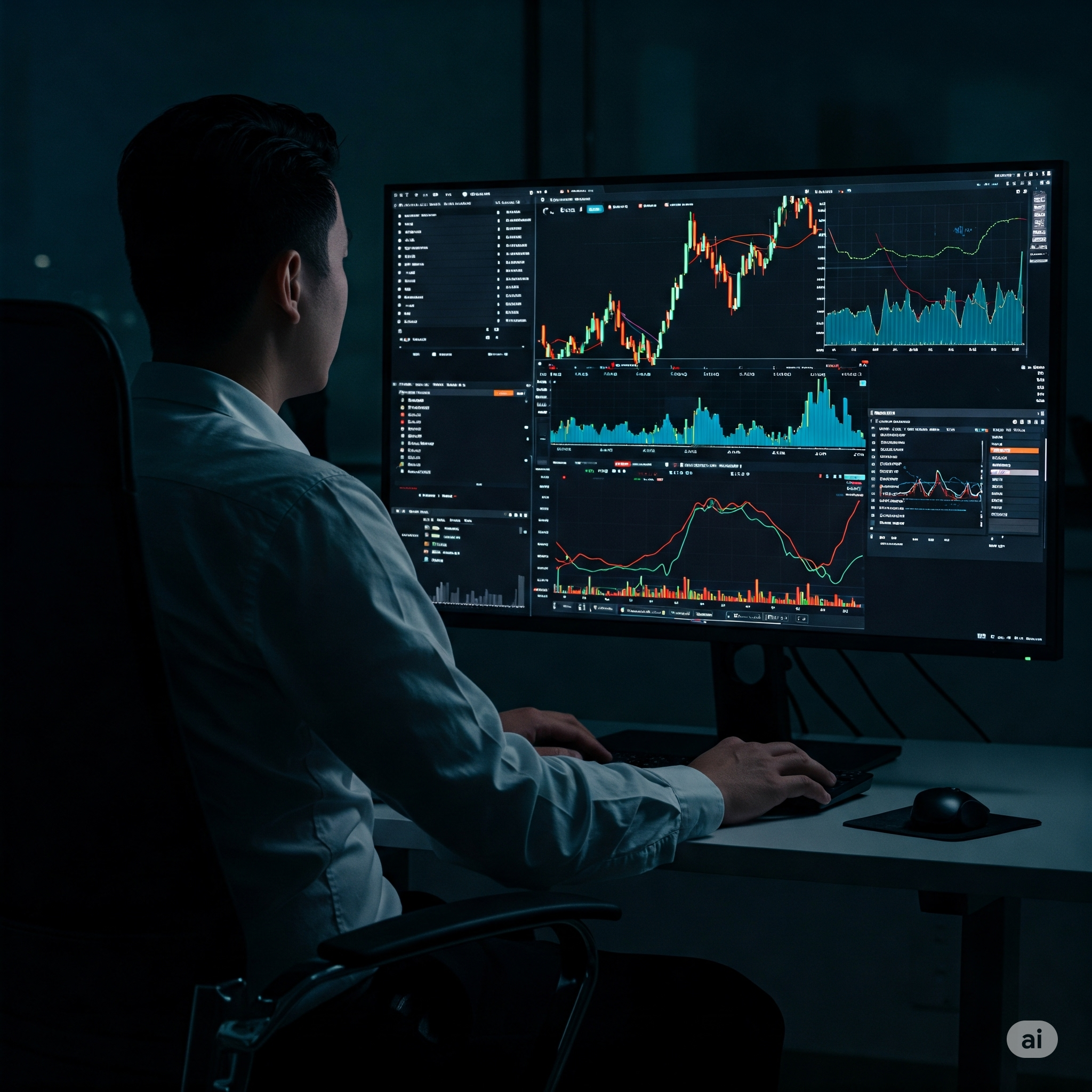How Do I Teach Myself to Trade Forex?

Learning to trade Forex trading requires dedication, practice, and an understanding of the fundamental and technical aspects of the market. Hereâs a step-by-step guide on how you can teach yourself to trade Forex:
- Understand the Basics of Forex Trading:
- Start by understanding what Forex trading is. Forex (foreign exchange) trading involves buying and selling currency pairs like EUR/USD, GBP/USD, etc. It is one of the largest and most liquid markets in the world.
- Study Forex Terminology:
- Learn key terms like pips, lots, spreads, leverage, margin, and currency pairs. This foundational knowledge is crucial as it helps you understand how trading works.
- Choose a Reliable Forex Broker:
- A broker acts as an intermediary between you and the Forex market. Choose a regulated broker that provides a user-friendly platform, good customer support, and favorable trading conditions.
- Utilize Educational Resources:
- There are plenty of free and paid resources online. Consider using books, online courses, webinars, and trading forums. Websites like BabyPips and Investopedia provide comprehensive guides on Forex trading.
- Practice with a Demo Account:
- Before risking real money, open a demo account with a broker and practice trading. This will help you understand how the market works, how to place trades, and how to manage risk without losing any money.
- Develop a Trading Plan:
- A trading plan outlines your trading goals, risk tolerance, trading strategy, and money management rules. A solid plan helps you stay disciplined and avoid impulsive decisions.
- Learn Technical and Fundamental Analysis:
- Technical analysis involves analyzing price charts and patterns, while fundamental analysis focuses on economic news and indicators. Both are crucial for making informed trading decisions.
- Start Small and Manage Your Risk:
- Start with a small amount of capital to get the feel of live trading. Use proper risk management techniques, such as not risking more than 1-2% of your trading capital on a single trade.
- Keep a Trading Journal:
- Track your trades, strategies, and emotions in a journal. This will help you identify what works and what doesn't, allowing you to refine your approach over time.
- Stay Updated and Keep Learning:
- Forex markets are constantly changing, and staying informed is key. Follow financial news, keep learning, and adapt to new market conditions.
What is Forex Trading and How Does it Work?
Forex trading,
also known as foreign exchange trading, is the process of buying and selling currencies in the global market. It is the largest financial market in the world, with a daily trading volume exceeding $6 trillion.
How Forex Trading Works:
- Currency Pairs:
- In Forex trading, currencies are traded in pairs (e.g., EUR/USD, GBP/JPY). The first currency in the pair is the base currency, and the second is the quote currency. Traders speculate on whether the base currency will strengthen or weaken against the quote currency.
- Bid and Ask Prices:
- The bid price is the price at which a trader can sell a currency pair, while the ask price is the price at which they can buy it. The difference between the bid and ask price is called the spread, which represents the brokerâs commission.
- Leverage and Margin:
- Leverage allows traders to control a large position with a relatively small amount of capital. For example, with 1:100 leverage, a trader can control $100,000 with just $1,000. However, leverage also increases risk, so it's important to use it wisely.
- Market Participants:
- The Forex market consists of various participants, including banks, financial institutions, hedge funds, corporations, governments, and retail traders. Retail traders can access the market through brokers.
- Types of Orders:
- Traders can place various types of orders, such as market orders (executed immediately at the current market price), limit orders (executed at a specified price), and stop-loss orders (automatically close a trade when it reaches a certain loss).
- Trading Sessions:
- The Forex market operates 24 hours a day, five days a week, and is divided into different trading sessions: the Asian, European, and North American sessions. Each session has its own characteristics and trading volume.
Let's illustrate a basic Forex trade with an example:
- Suppose you believe that the euro (EUR) will strengthen against the US dollar (USD). You decide to buy EUR/USD at 1.1200.
- If the EUR/USD pair rises to 1.1300, you have made a profit. The difference of 100 pips (1.1300 - 1.1200) represents your gain.
- If you traded a standard lot (100,000 units), the profit would be $1,000 (100 pips x $10 per pip).
However, if the market moves against you and the EUR/USD pair falls to 1.1100, you would incur a loss of $1,000. This example highlights the potential for profit and loss in Forex trading and the importance of
risk management.
How Can I Start Forex Trading as a Beginner?
Forex trading as a beginner involves several steps:
- Choose a Reliable Broker:
- Research and select a broker that meets your needs in terms of fees, trading platforms, customer support, and regulatory compliance.
- Open a Trading Account:
- Fund Your Account:
- Deposit funds into your trading account using available payment methods. Start with a small amount to minimize risk.
- Download a Trading Platform:
- Most brokers offer trading platforms like MetaTrader 4 (MT4) or MetaTrader 5 (MT5). Download and familiarize yourself with the platform's features.
- Develop a Trading Strategy:
- Create a trading strategy based on technical and fundamental analysis. Decide on entry and exit points, stop-loss levels, and risk management rules.
- Start Trading:
- Execute your trades based on your strategy. Always use stop-loss orders to limit potential losses and take-profit orders to secure profits.
- Monitor and Analyze Your Trades:
- Continuously monitor the market, analyze your trades, and adjust your strategy as needed.
- Stay Educated:
- Stay updated with the latest market news, economic indicators, and trading strategies. Participate in trading communities and forums to learn from other traders.
How Much Money Do I Need to Start Forex?
The amount of money needed to start Forex trading depends on several factors:
- Minimum Deposit Requirements:
- Most brokers have a minimum deposit requirement, ranging from $10 to $500. As a beginner, it is advisable to start with a small amount and gradually increase your capital as you gain experience.
- Leverage:
- Leverage allows you to control a large position with a small amount of capital. For example, with 1:100 leverage, a $100 deposit can control a $10,000 position. However, higher leverage increases the risk of losing money quickly.
- Risk Management:
- Effective risk management involves not risking more than 1-2% of your trading capital on a single trade. For example, if you have $1,000 in your account, you should risk no more than $10-$20 per trade.
- Trading Style:
- Your trading style (scalping, day trading, swing trading, or position trading) will influence the amount of capital needed. Scalping and day trading require more capital due to higher frequency and tighter stop-loss levels.
In summary, you
can start Forex trading with as little as $100, but it is recommended to have at least $500 to $1,000 to provide flexibility and room for risk management.
Is Forex Trading Good for Beginners?
Forex trading can be good for beginners, but it comes with risks and challenges. Here are some pros and cons to consider:
Pros:
- Accessibility:
- Forex trading is accessible to everyone with an internet connection. Many brokers offer low minimum deposits and demo accounts to practice trading.
- High Liquidity:
- The Forex market is highly liquid, meaning there are always buyers and sellers available. This liquidity ensures tight spreads and quick trade executions.
- Leverage:
- Leverage allows traders to control large positions with a small amount of capital. This can amplify profits if trades go in the desired direction.
- 24/5 Trading:
- The Forex market operates 24 hours a day, five days a week, allowing traders to trade at any time that suits them.
Cons:
- High Risk:
- Forex trading is highly speculative and comes with a high risk of losing money. Most beginners lose money due to a lack of experience, knowledge, and poor risk management.
- Leverage Risks:
- While leverage can amplify profits, it can also magnify losses. Beginners should be cautious when using leverage and always use stop-loss orders.
- Emotional Trading:
- The Forex market is highly volatile, and emotions can lead to impulsive decisions. It is important to remain disciplined and follow a trading plan.
- Learning Curve:
- Forex trading requires time, effort, and dedication to learn. Beginners need to invest in education, practice with a demo account, and gradually transition to live trading.
Forex trading can be rewarding for beginners who are willing to learn and practice. However, it requires a strong understanding of the market, effective risk management, and continuous learning. Starting with a demo account, developing a trading plan, and managing risk effectively can help beginners succeed in the Forex market.
End of Article


Comments